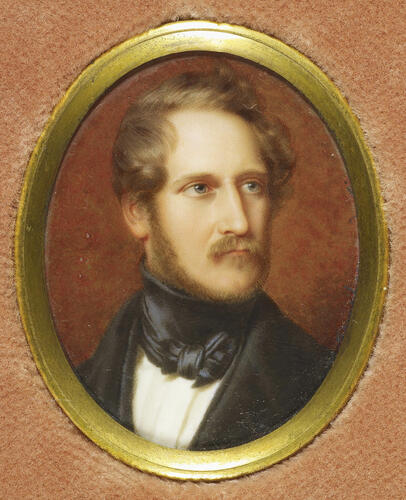Jean-Baptiste Duchesne (de Gisors) (1770-1856)
Duke Alexander of Würtemberg (1804-1863) c.1835-60
5.1 x 4.0 cm (frame, external) | RCIN 422190
-
The son of the sculptor Charles-Jean-Baptiste Duchesne, Jean-Baptiste may have trained initially as a sculptor with his father, but his first work as a miniaturist dates to 1794, In Paris he received instruction from F.-A. Vincent and from J.-B.-J. Augustin, in the techniques of painting on ivory and enamel, and soon became very successful, exhibiting at the Salon 1802 – 42, and being appointed Chevalier de la Légion d'honneur in 1814. His most influential patron at this period was Marie Caroline, duchesse de Berry (1798 – 1870), In 1840 Duchesne de Gisors was invited to continue the series of enamels in the Louvre by Jean Petitot. It was at this late stage in his career that he was first recommended to Queen Victoria in September 1841 by her aunt, Queen Louise of the Belgians. He produced a number of enamels for Queen Victoria during the following decade, until his advancing age brought his work for her to a close.
A copy by Duchesne de Gisors after an unlocated portrait by Franz Xaver Winterhalter dating from 1838. In a response to a letter from her uncle, Leopold I, King of the Belgians, in July 1837 calling the Duke of Württemberg 'not … bad looking, but … too large, too colossal', Queen Victoria wrote: 'You do not think Al-exander near handsome enough in my opinion; you know ladies are much better judges; he is somewhat colossal I own, but very proportionate & good-looking I think'
.
Alexander, Duke of Württemberg, elder son of Duke Alexander of Württemberg, and Antoinette, aunt of Queen Victoria and Prince Albert and daughter of Francis Anthony, Duke of Saxe-Coburg-Saalfeld, married, in 1837, Marie d'Orléans, second daughter of Louis-Philippe, King of the French. She died of consumption the year after giving birth to their only son Philip. He visited England as a young man in 1833 and again with his son in 1850.
Signed along the right-hand edge under the mount in black paint: [Duchesne] and signed and inscribed on the counter-enamel in red paint by the artist: [Alexan]dre / [Duc de] Wurtemberg / né [le] 20 Decembre 1804 / Duchesne de Gisors / faciebat. -
Creator(s)
-
Medium and techniques
Measurements
5.1 x 4.0 cm (frame, external)
4.3 x 4.0 cm (sight)
Other number(s)








